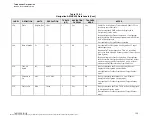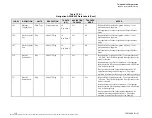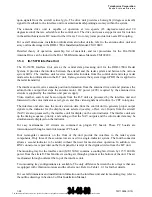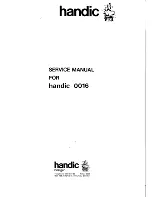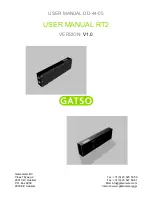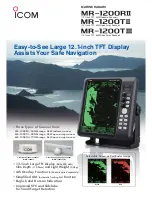
Telephonics Corporation
R
A D A R
S
Y S T E M S
D
I V I S I O N
1-28
TM113806 (3/10)
upon signals from the aircraft vertical gyro. The drive unit provides a boresight (0 degrees azimuth)
signal for feedback to the interface unit to maintain azimuth-pointing accuracy within the system.
The antenna drive unit is capable of operation at two speeds (45 degrees/second and 90
degrees/second) that are selectable at the control unit. The drive unit uses a stepper motor for rotation
in the azimuth axis and a DC motor for the tilt axis. Two rotary joints provide inter-axis RF coupling.
For overall dimensions, installation information, and other details, refer to the antenna drive unit and
array outline drawings in the RDR-1700A Installation Manual, TM110402.
Detailed theory of operation, assembly, list of materials, and test procedures for the DA-1503B
Antenna Drive can be found in the DA-1503B Maintenance Manuals, TM109202.
1.5.4 IU-1507B
Interface
Unit
The IU-1507B Interface Unit acts as the central data processing unit for the RDR-1700A Radar
System. It provides the interface between the aircraft and the radar system and between the various
system LRUs. The interface unit receives mode selection data from the control unit and relays radar
mode selection information to the R-T unit. It also generates the system trigger (PRF) that is applied to
the radar transmitter.
The interface unit receives antenna position information from the antenna drive unit and produces the
azimuth drive output that steps the antenna motor. DC power (±20V) required by the antenna drive
circuits is supplied by the interface unit power supply.
Video weather, search, and beacon inputs from the R-T unit are processed by the interface unit and
forwarded to the color indicator as red, green, and blue video signals used to drive the CRT color guns.
The interface unit also uses the mode selection data from the control unit to generate proper output
signals to the indicator for the display mode selected (overlay, offset, etc.). Inputs from the aircraft
(NAV) are also processed by the interface unit for display on the color indicator. The interface unit sets
up the timing sequence, priority, and coding so that the NAV outputs and the color radar data may be
simultaneously displayed on the indicator.
For easy maintenance, all circuits are contained on plug-in PC boards. These PC boards are
interconnected through a main interconnect PC board.
Four rectangular connectors on the front of the unit provide the interface to the radar system
components. Only three of these connectors are used in a single-indicator system. The fourth connector
allows a second indicator to be added without the need for master-slave operation. In addition, two
BNC connectors are provided on the front panel for receipt of the digitized video from the R-T unit.
The mounting tray for the interface unit (MT-1508A) contains a cooling fan, driven by 115V 400 Hz
power from the aircraft. This fan directs cooling air through a plenum at the bottom of the unit. The air
is exhausted through outlets at the top of the interface unit.
Two mounting tray configurations are available. The only difference between the two trays is that one
is equipped with vibration isolators and the other is not. Refer to Table 1.2-1 for further details.
For overall dimensions and installation information on the interface unit and its mounting tray, refer to
the outline drawings in Section 2 of this Installation Manual.
The document reference is online, please check the correspondence between the online documentation and the printed version.


